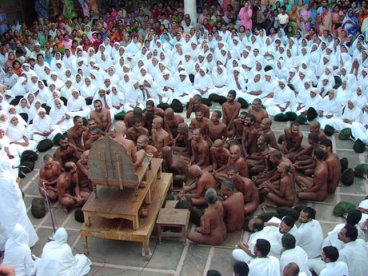Taoism was founded by Lao-Tse, a contemporary of Confucius in China. Taoism began as a combination of psychology and philosophy which Lao-Tse hoped would help end the constant feudal warfare and other conflicts of his time. His writings, the Tao-te-Ching, describe the nature of life, the way to peace and how a ruler should lead his life. Taoism became a religion in 440 CE when it was adopted as a state religion.
Tao, roughly translated as path, is a force which flows through all life and is the first cause of everything. The goal of everyone is to become one with the Tao. Tai Chi, a technique of exercise using slow deliberate movements, is used to balance the flow of energy or "chi" within the body. People should develop virtue and seek compassion, moderation and humility. One should plan any action in advance and achieve it through minimal action. Yin (dark side) and Yang (light side) symbolize pairs of opposites which are seen through the universe, such as good and evil, light and dark, male and female. The impact of human civilization upsets the balance of Yin and Yang. Taoists believe that people are by nature, good, and that one should be kind to others simply because such treatment will probably be reciprocated.
Modern Taoism falls into main categories: 'Southern' Taoism, popular in Taiwan and South China and 'Northern' Taoism, a tradition largely unknown to Westerners but widely practised among modern Taoists in mainland China.
Southern Taoism
Southern Taoism is an offshoot of Cheng-i Taoism, the only liturgical tradition surviving today. The modern Cheng-i tradition dates back to the 11th century. Its priests still perform liturgies like the chiao, believed to harmonise the local community with the cosmos. They also perform healing rituals and exorcisms in public. But these activities are frowned upon by 'Northern' Taoists. Northern Taoism
The outside world knew little about the existence of Northern Taoism until the 1980s because few foreigners were allowed to enter mainland China under conditions that allowed them to experience the country's religious culture. For a time there was also a question mark over whether Taoism had survived the crackdown on all religions in China from 1966 to 1976.
Northern Taoism grew out of the Ch'üan-chen tradition. It was founded in the 12th century by Wang Chu'ung-yang. It emphasises moral and spiritual discipline and also continues self-preservation practices that date back to the classical Nei-yeh. Its headquarters are at White Cloud Abbey in Beijing.
Other groups
There are other Taoist groups but none of them is believed to exist in its original form. Some of them are listed below:
- Chin tan (Golden Elixir) Taoism - a tradition strong on meditation or 'Inner Alchemy'. Much of this practice was absorbed into the Ch'üan chen tradition.
- Ch'ing wei (Clarified Tenuity) Taoism - A complex of ritual traditions that trace back to a young woman, Tsu Shu.
- T'ien hsin (Heart of Heaven) Taoism - A tradition of ritual healing based upon scriptures discovered in the early Sung period by a retired official, Jao Tung-t'ien.
- Shen hsiao (Divine Empyrean) Taoism - A liturgical tradition established by Lin Ling-su at the court of the Sung emperor Hui tsung (early 12th century).
- T'ung-ch'u (Youthful Incipience) Taoism - An obscure tradition of therapeutic rituals founded by a young man in 1121, claiming continuity with the Shang-ch'ing tradition.
- T'ai i (Supreme Union) Taoism - Founded by Hsiao Pao chen in the 12th century, it stressed ritual healing and social responsibility.
- Chen ta (Perfected Greatness) or Ta-tao (Great Way) Taoism - Founded by Liu Te-jen in the 12th- century. It combined the basic moral teachings of Buddhism, Confucianism and Taoism and was patronized by the Chin government.
source: www.bbc.co.uk/religion/religions/taoism/.../subdivisions_1.shtm

 This is an ideogram for water that is often used to represent Confucianism. It represents the source of life in Chinese philosophy.
This is an ideogram for water that is often used to represent Confucianism. It represents the source of life in Chinese philosophy. This is a symbol often used in wedding ceremonies within the Chinese culture. It is also sometimes used to represent Confucianism. It means total harmony, righteousness, in your own life and in your relationships with others.
This is a symbol often used in wedding ceremonies within the Chinese culture. It is also sometimes used to represent Confucianism. It means total harmony, righteousness, in your own life and in your relationships with others. The yin-yamg symbol of Taoism is also sometimes used as a symbol for Confucianism. It symbolizes balance in nature between opposing forces. Unbalance can lead to confusion and dissaray.
The yin-yamg symbol of Taoism is also sometimes used as a symbol for Confucianism. It symbolizes balance in nature between opposing forces. Unbalance can lead to confusion and dissaray.